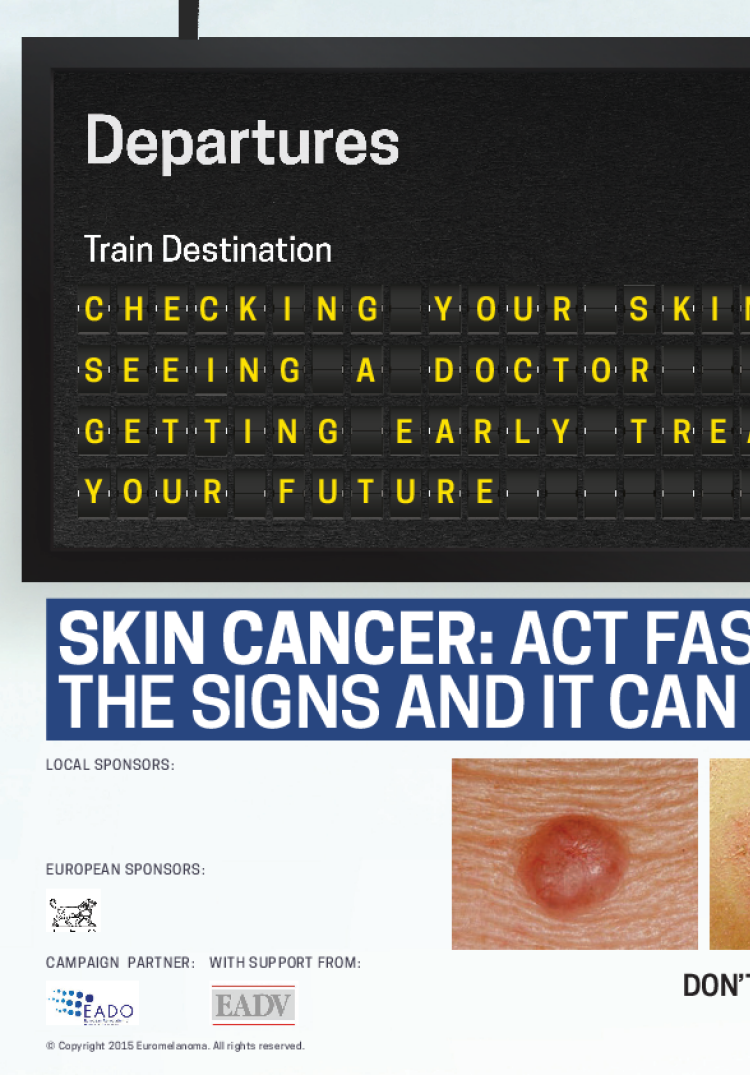2015 Kampanj
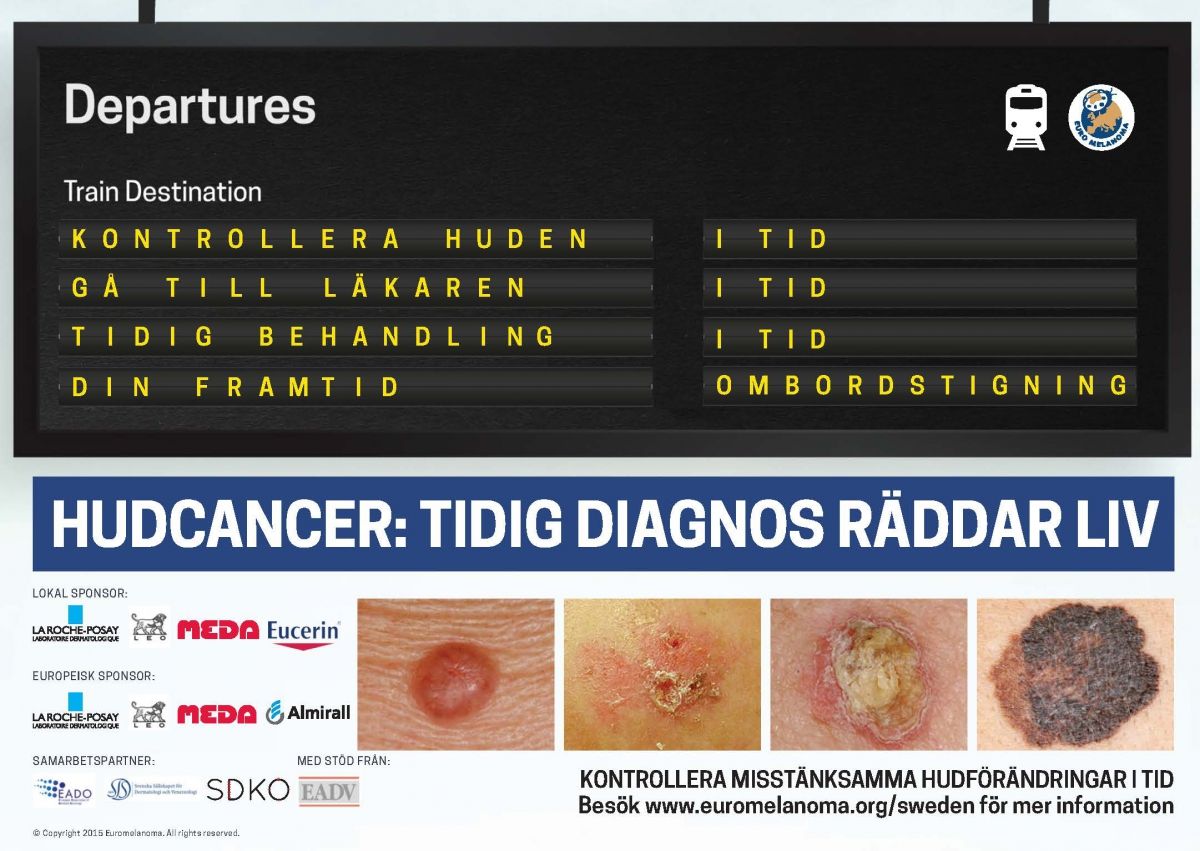
Hudcancer. Tidig diagnos räddar liv.
Download, read and share.
We have prepared educational materials. You will find useful advices.
Feel free to download these documents and share them with your family, friends, colleagues...
People are traveling in your offices, lounges, corridors, health club, shops, waiting rooms?
Your job will take you to see, touch or take care of the skin of your clients? Do not miss out of danger.
Preventing skin cancer
Skin cancer is one of the world’s most common cancers. The good news is that it is usually treatable if detected early - and there are things we can do to prevent it.
Always be sunsafe
Avoid unnecessary exposure.
Seek shade where possible, and avoid the summer sun during the middle of the day.
Wear protective clothing
Include dark colours, long sleeves, a widebrimmed hat and UV-rated sunglasses.
For children, look for clothing with inbuilt sun protection.
Apply sunscreen
Check that yours has a high protection factor against both UVA and UVB rays. Remember that sunscreen takes effect around half an hour after its application and only lasts for two to three hours.
Protect children
Children are at the greatest risk of long-term health issues related to unsafe sun exposure.
Outside play is important, but you should never let a child get sunburnt.
Vem som helst kan utveckla hudcancer, oavsett ålder. Men det förekommer oftast hos personer över 50 år och hos personer som har vistats mycket i solen, men det kan också drabba människor med lägre risk.
Du löper en högre risk att utveckla hudcancer om du:
-
har ljus hudtyp och lätt för att bli bränd av solen
-
har blivit bränd av solen under barndomen eller senare i livet
-
tillbringar mycket tid ute i solen (antingen på jobbet eller på fritiden)
-
använder solarium
-
har totalt mer än 50 födelsemärken på kroppen
-
har andra i familjen som har, eller har haft, hudcancer
-
är över 50 år
-
har genomgått en organtransplantation
Även om du inte är i riskzonen för att utveckla hudcancer, är det viktigt att du är medveten om vad som orsakar cancer och vilka symptom det ger. De val du gör tidigt i livet, kommer att påverka risken för att utveckla cancer senare i livet. Om du är medveten om riskfaktorerna och symptomen, kan du bättre skydda dig mot skador och även hjälpa till att upptäcka hudcancer hos dina närmaste.
Melanoma
Detta är den mest sällsynta formen av hudcancer, men också den allvarligaste. Den kan drabba människor i alla åldrar, till skillnad från andra hudcancerformer, som är vanligast hos äldre personer. Ett malignt melanom kan ha mycket varierande utseende. Det kan vara en mörk pigmentfläck med oregelbundna gränser eller som med tiden ändrar färg. Men det kan också vara en snabbt växande rosa eller röd knuta i huden. Det kan spridas till inre organ, så här är omedelbar behandling nödvändig.
BasalCellsCancer, Basaliom
Detta är den vanligaste formen av hudcancer, men också den minst allvarliga. Den brukar visa sig som en förhöjd knuta i huden med blank yta. Den ser ut som ett sår med skorpa på som inte läker, och växer långsamt. Om denna inte behandlas, kan den utvecklas till större sår som går djupare ned i huden.
Squamous cell carcinoma
This is the second most common form of skin cancer, occurring in areas of the skin that have had a lot of sun exposure, such as the face and scalp. It presents as a crusty lump which may grow quickly and become ulcerated and weepy. It can spread rapidly, especially if on the lips, ears, fingers and toes, or in immunosuppressed patients. Surgical treatment to remove the lesions is essential.
Actinic keratosis
This occurs most commonly in middle-aged and elderly people, on areas most exposed to the sun such as the face, neck, ears, back of the hands and scalp. It presents as red-brown scaly and rough patches of skin. The lesions are pre-cancerous; in 10– 15% of cases they may develop into squamous cell carcinomas, so they should be treated to prevent progression.
Man ska vara uppmärksam på alla förändringar i pigmentfläckar i huden, bland annat förändringar i storlek, form och färg. Om
en ny fläck ser annorlunda ut i jämförelse med befintliga prickar ska man vara misstänksamt.
Detta kallas för fulla ankungen (ugly duckling) tecken.
ABCDE reglerna för tidigt upptäckning av melanom:
A. Asymmetri?
B. Oregelbunda kanter- BORDERS?
C. Olika färger - COLOURS?
D. Är DIAMETER större än 5 mm?
E. Har den ändrad? EVOLUTION?
Det tar bara några minuter 1 gång /månaden för att kontrollera sig själv för hudcancer. Det är mycket enkelt, och det kan faktiskt rädda ditt liv!
Din kontroll ska omfatta hela kroppen, fram och bak, med särskild tonvikt på områden som exponeras för solen. Stå framför en helfigursspegel med en handspegel för de svåråtkomliga ställen.
1. Titta noga i ansiktet, speciellt näsan, läpparna, munnen och öronen (fram/bak). Använd två speglar om det behövs.

2. Titta noga i hårbotten, använd en kam eller hårtork för att se bättre. Om du inte har mycket hår, är det viktigt att undersöka hela hårbotten noggrant.

3. Kolla dina händer, både handflatan och handryggen (även mellan fingrarna).

4. Sedan kollar du halsen, bröstet och överkroppen. För kvinnor är det viktigt att även se mellan och under brösten.

5. Glöm inte armhålan och gå ner över armbåge, underarm.

6. Vänd ryggen mot den stora spegeln och använd handspegeln för att undersöka ryggen. Börja uppe i nacken och på axlarna och gå ner mot ländryggen.

7. Kontrollera skinkorna och mellan de, baksidan av låren och benen och fortsätt ner till hälarna.

Hudfläckar är vanliga, kan komma när som helst i livet, och är ofta ofarliga. Men ibland finns varningstecken på mer allvarliga problem.
VAD ska du kolla:
Kolla huden för:
Generellt bör man vara uppmärksam på fläckar på huden som
-
ändrar färg, storlek eller form
-
skiljer sig från andra fläckar
-
är asymmetriska eller har oregelbundna kanter
-
är större än 5 mm i diameter
-
känns grova eller fjällar (ibland kan du känna en skada innan den blir synlig)
-
har olika färgnyanser
-
kliar
-
blöder eller vätskar sig
-
har en blank yta
-
ser ut som ett sår men inte läker
Om du ser 2 eller flera tecken , vänta inte! Boka tid hos din läkare idag!
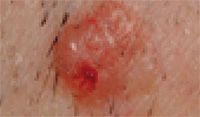
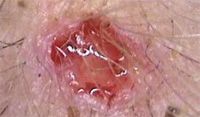
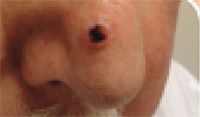
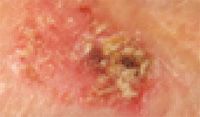
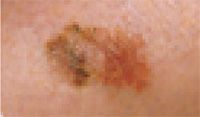
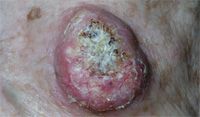
Om du upptäcker en hudförändring som ser misstänkt ut , är det viktigt att du får kontrollerat denna hos din läkare så snart som möjligt.
Hudcancer kan behandlas, och en tidig diagnos ökar chanserna att bli helt frisk.
Om behandlingen kommer igång sent, kan tillståndet förvärras, och i vissa fall kan det leda till komplikationer, och i värsta fall döden.
Låt inga dåliga ursäkter minska dina chanser att bli frisk.
Det är alltid bättre att vara säker än ledsen.
KOM IHÅG
Du måste agera snabbt om du ser tecken på hudcancer. Dröj inte; besöka din läkare så fort du ser något ovanligt.
För mer information om hudcancer, de olika typerna av skador och vad de betyder, besök gärna mer på vår hemsida www.euromelanoma.org
